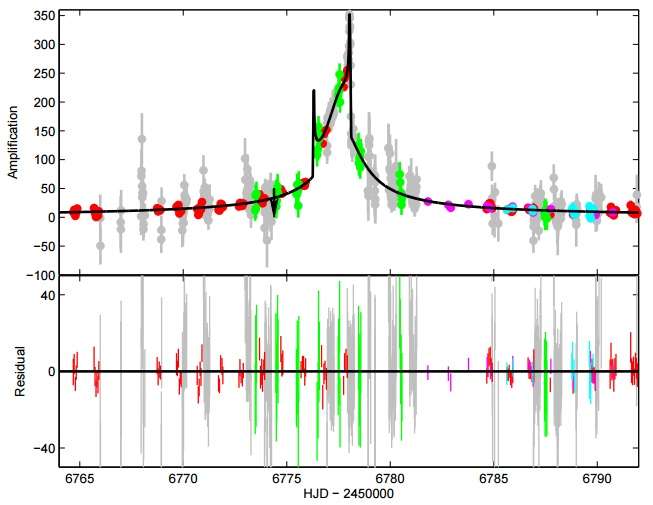December 14, 2016 report
Astronomers discover new gas giant exoplanet

(Phys.org)—Using the gravitational microlensing method, an international team of astronomers has recently detected a new gas giant exoplanet three times more massive than Jupiter. The newly discovered planet received designation OGLE-2014-BLG-0676Lb and is an important addition to the short list of extrasolar worlds detected by the microlensing technique. The discovery was described in a paper published Dec. 12 on arXiv.org.
Unlike other methods of detecting exoplanets, microlensing is most sensitive when it comes to searching for exoworlds that orbit around one to 10 AU away from their host stars. These planets are of special interest for astronomers studying planetary formation theories due to proximity to their parent stars, within the so-called "snow line." Just beyond this line, the most active planet formation occurs; therefore, understanding the distribution of exoplanets in this region could offer important clues to how planets form.
So far, 47 planets have been discovered by microlensing. Currently, several ground-based observation programs routinely monitor dense stellar fields to search for microlensing events. When a new event is discovered, an alert to the broader scientific community is issued in order to allow follow-up observations. Astronomers are particularly interested in events showing evidence for perturbations that could be due to the presence of a planet, or which are predicted to have a high sensitivity to such perturbations.
OGLE-2014-BLG-0676, discovered in April 2014 by a Polish astronomical project called the Optical Gravitational Lensing Experiment (OGLE), is one of those interesting microlensing events. Recently, a collaboration of researchers consisting of the OGLE group, the Microlensing Observations in Astrophysics (MOA), the Wise Observatory Group and the Microlensing Network for the Detection of Small Terrestrial Exoplanets (MiNDSTEp), has detected an anomalous signal in this event consistent with a planetary lens system.
"The source star passed through the central caustic, with the second caustic crossing being well recorded by the MOA microlensing survey collaboration. Observations at epochs between the unrecorded first caustic crossing and the second caustic crossing were made by the OGLE, Wise and MOA collaborations. (…) All analyses of the light curve data favor a lens system comprising a planetary mass orbiting a host star," the paper reads.
According to the research, the newly discovered planet has a mass of about 3.1 Jupiter masses and orbits its parent star at a deprojected orbital separation of about 4.4 AU. The host star is approximately 38 percent less massive than our sun and was classified as a K-dwarf. The distance to the lens system is about 7,200 light years.
Moreover, the team revealed some information about the source star. They revealed that is rather faint and very red, noting that there is a possibility that the source may be blended with a nearby red star, causing an incorrect identification of the source star type.
In conclusion, the scientists emphasize the importance of their discovery, noting that OGLE-2014-BLG-0676Lb could serve as a test bed for planet formation scenarios. "Planet OGLE-2014-BLG-0676Lb can be added to the growing list of planets discovered by microlensing against which planetary formation theories can be tested," the researchers wrote in the paper.
More information: N. J. Rattenbury et al. Faint source star planetary microlensing: the discovery of the cold gas giant planet OGLE-2014-BLG-0676Lb, Monthly Notices of the Royal Astronomical Society (2016). DOI: 10.1093/mnras/stw3185 , On Arxiv: arxiv.org/abs/1612.03511
Abstract
We report the discovery of a planet —- OGLE-2014-BLG-0676Lb —- via gravitational microlensing. Observations for the lensing event were made by the MOA, OGLE, Wise, RoboNET/LCOGT, MiNDSTEp and μFUN groups. All analyses of the light curve data favour a lens system comprising a planetary mass orbiting a host star. The most favoured binary lens model has a mass ratio between the two lens masses of (4.78±0.13)×10−3. Subject to some important assumptions, a Bayesian probability density analysis suggests the lens system comprises a 3.09+1.02−1.12 M_jup planet orbiting a 0.62+0.20−0.22 M_sun host star at a deprojected orbital separation of 4.40+2.16−1.46 AU. The distance to the lens system is 2.22+0.96−0.83 kpc. Planet OGLE-2014-BLG-0676Lb provides additional data to the growing number of cool planets discovered using gravitational microlensing against which planetary formation theories may be tested. Most of the light in the baseline of this event is expected to come from the lens and thus high-resolution imaging observations could confirm our planetary model interpretation.
Journal information: Monthly Notices of the Royal Astronomical Society , arXiv
© 2016 Phys.org




















